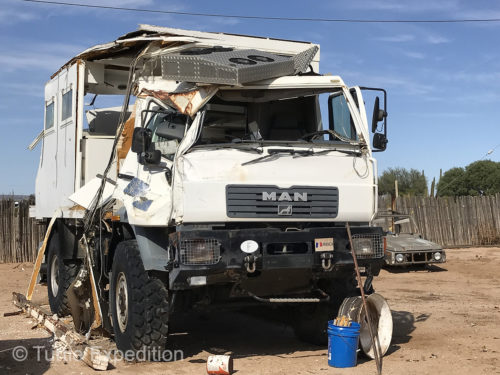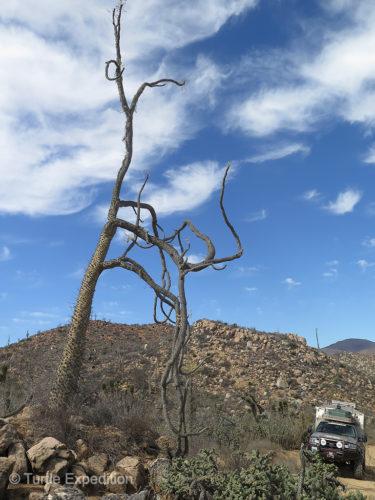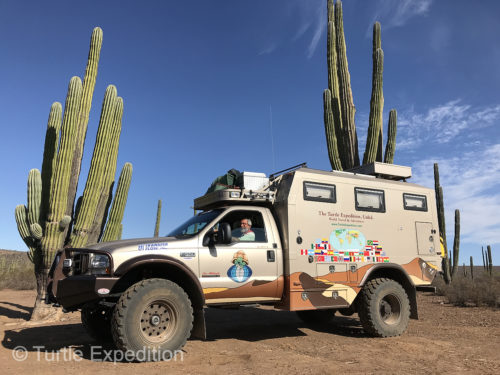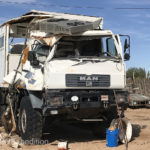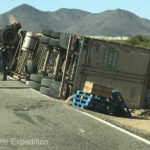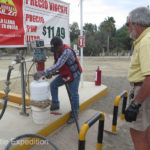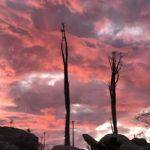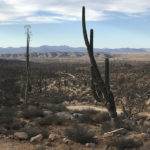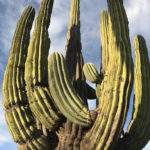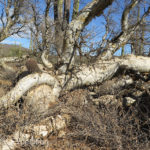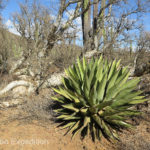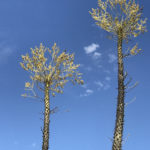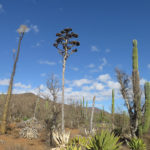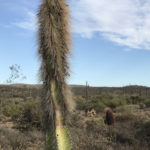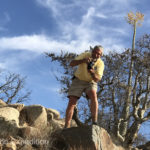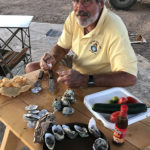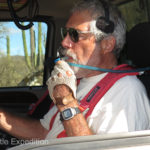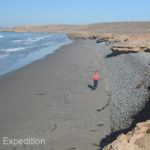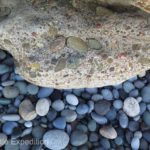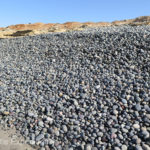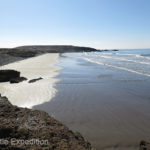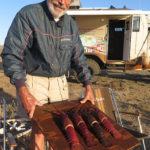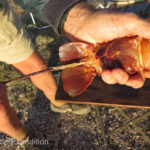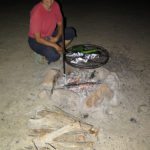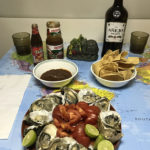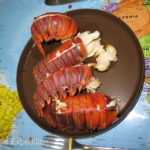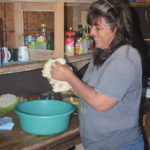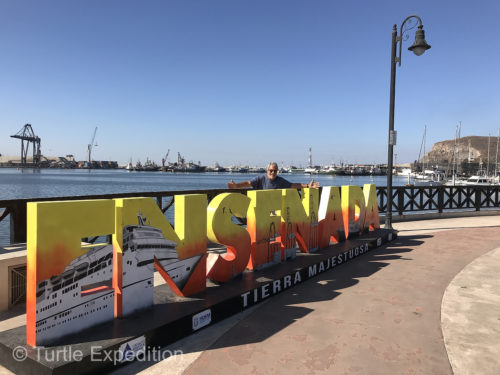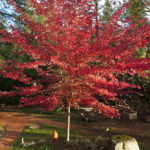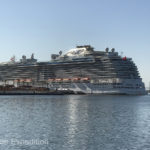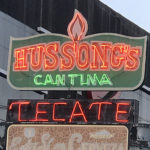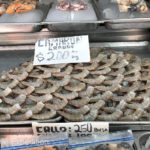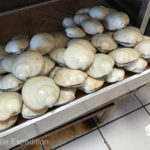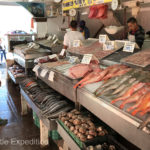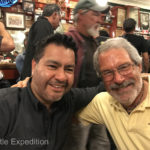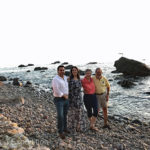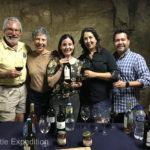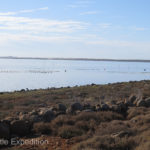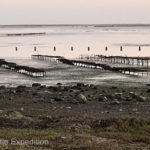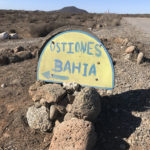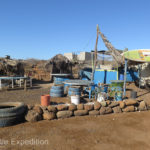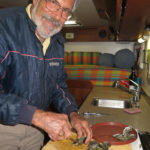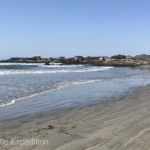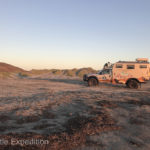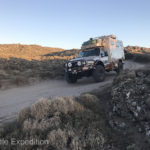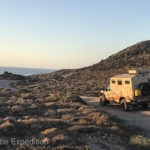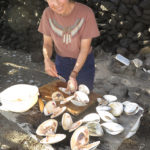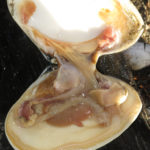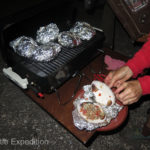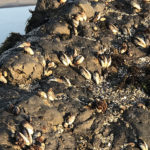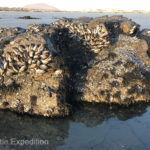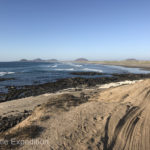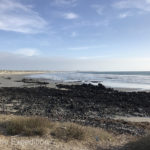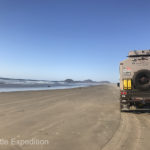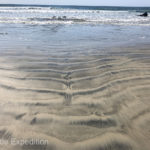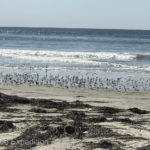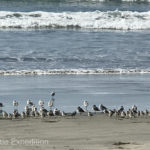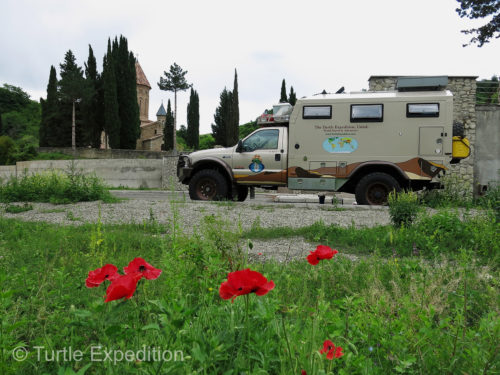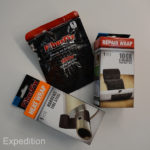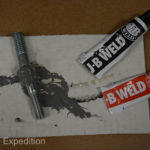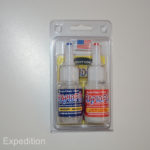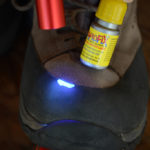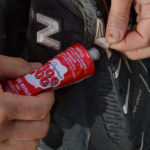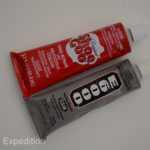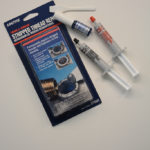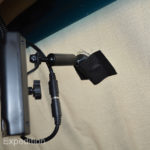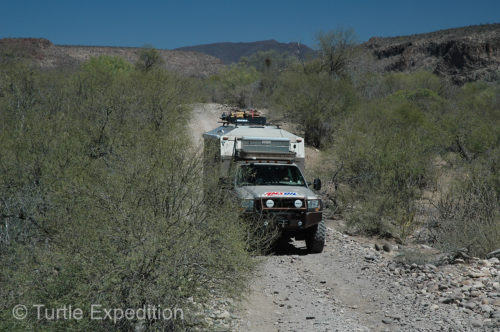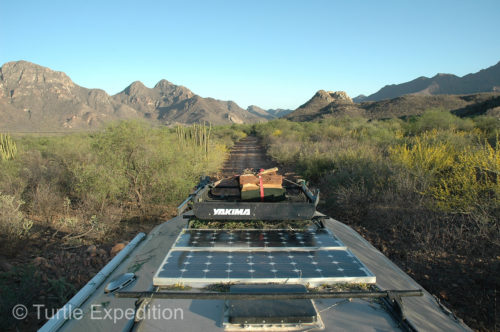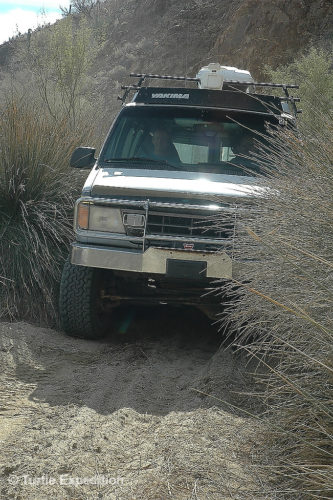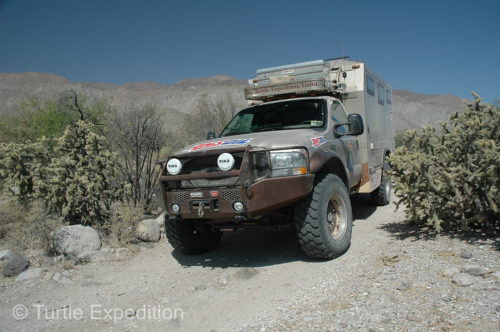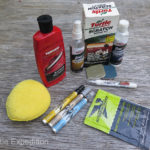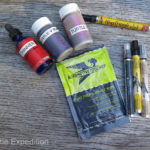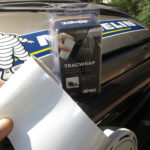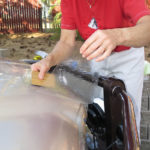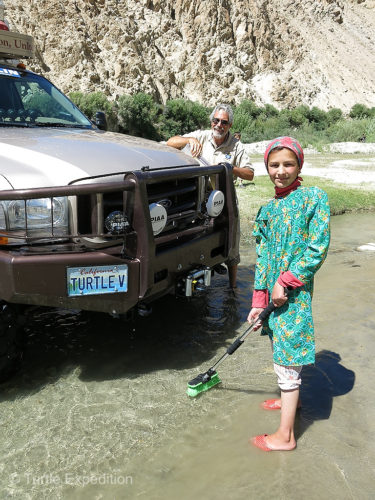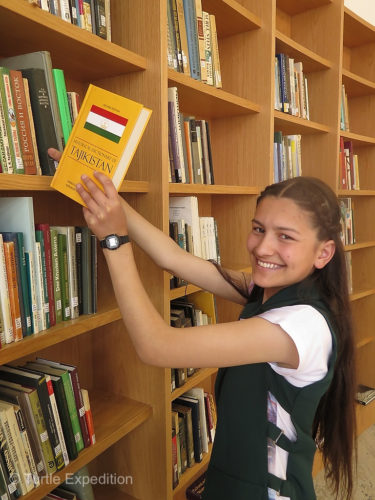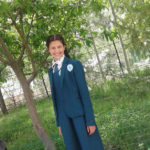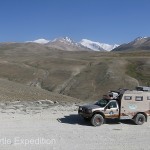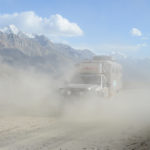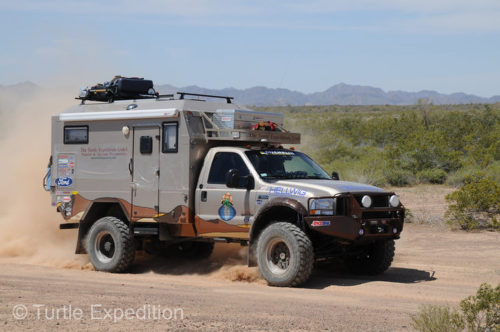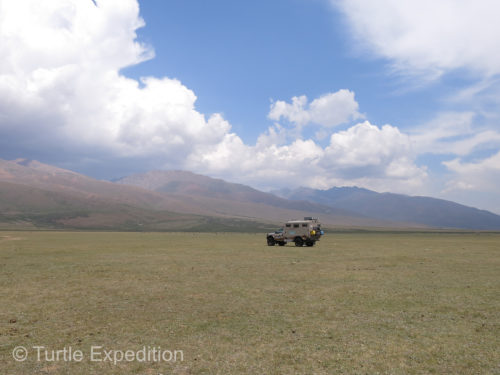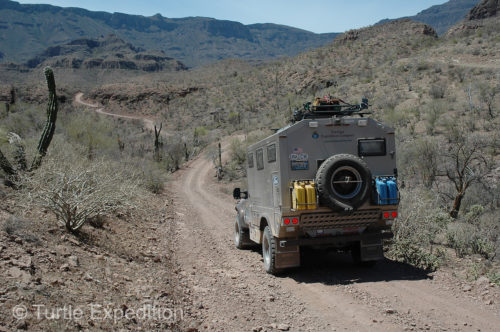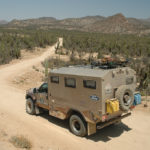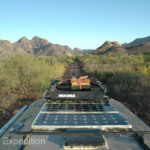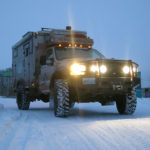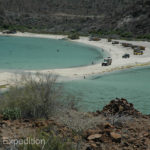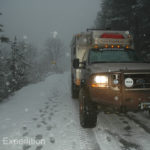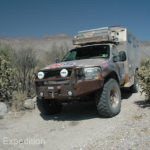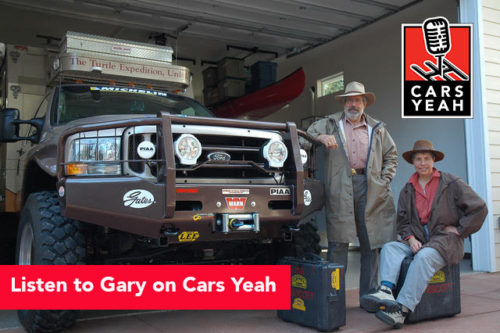Let’s walk through the camper
The Dinette
Our dinette table can sit four in a pinch, but it was sized and designed for two adults and it does not make into a bed. Six-inch medium dense foam with a reclined back make it ideal for working or eating or just relaxing. Behind each seat is a large compartment for dirty clothes or—-wine. Most campers have places for clothes but never for dirty clothes! The double-pane pass-through window to the cab is made of Lexan and securely locked from inside. When we camp, we unlock the window in the cab in case we need to climb through in an emergency.

Southern Utah, May 2015
Cockpit Control Panel
Above the dinette, Blue Sea electrical breaker switches control all 12V and 110V power sources with individual breakers for fans, step, solar panels, shore power, etc.
The PROsine control panel tells us the current charge of our Odyssey batteries, the temperature of the batteries, and allows us to switch from the 2000-watt inverter to the 100-amp charger.
The Xantrex Link 10 shows us the current charge on our battery system and exactly how many amp hours we have left based on current use.
The Blue Sky Solar Boost 2000E controller increases the charge current by operating the PV module in a manner that allows the module to produce all the power it is capable of. Patented Maximum Power Point Tracking (MPPT) technology allows Solar Boost 2000E to increase charge current up to 30% or more compared to conventional charge controllers.
Overhead Storage
As import as storage is in a small camper, we designed cabinets and top cupboards to maximize space for mostly light-weight items for everyday use that keeps the center of gravity low.
Kitchen Counter Tops
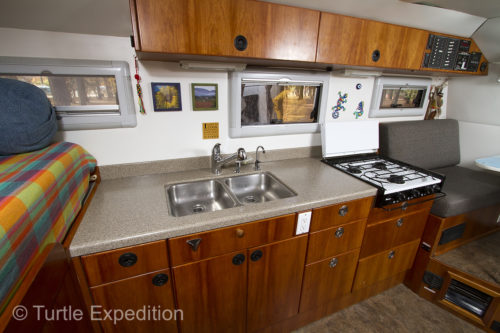
The Corian we used for countertops has survived extremely well. Small scratches can be polished out.
While we never shy away from interesting street food, we do 95% of the cooking ourselves. A well-equipped kitchen for preparing delicious and healthy meals had to include two sinks, plenty of counter space, filtered and purified water, (hot & cold), and a three-burner propane stove. For the surface of the counter tops we chose Corian, and we are really happy with its durability.
Why a Propane Stove?

Filling our propane tank from a local exchange tank in Greece was about a five minute job.
We had investigated and experimented with diesel stoves and there was no question that cooking with propane was and is the best choice over diesel, alcohol or induction plates. In case you never thought about it, the whole world cooks on propane, otherwise known as LP. It is important to understand that LP stands for—Liquid Petroleum. Yes, it is a liquid and we can find it and refill our Manchester LP tanks anywhere in the world using a local adaptor, purchased at a hardware store, and a local exchange tank. And by the way, did you ever try to BBQ some fresh fish filets on a diesel stove?
Barbecue – Oven & Microwave

Nothing like a fresh loaf of bread on a remote beach in Belize (1980).
In the Turtle V, we originally had an oven and a microwave. Both took up too much space for as little as they were used. We prefer our Weber Go-Anywhere portable grill to keep the heat outside of the camper. It connects to one of our LP tanks with a quick-disconnect valve. (see Turtle V #6 Camper 1)
If we really want to bake something, you would be amazed the bread and meatloaves we have prepared in a Coleman Folding Oven. Back in 1988 on Lake Titicaca in Peru, Monika even baked a pineapple upside down birthday cake in a pan on the stove.
BED
The bed is a 5” medium density mattress with a natural wool cover and fitted sheets. During the day it folds in half and the front base slides into the lower base, creating a comfortable day-bed. At night, it takes 30 seconds to make the full bed, leaving one sink open. All pillows, down comforter, light blanket and down jackets store in stuff bags that also serve as pillows as needed. The length of the bed—which ultimately determines the actual outside width of the camper’s box—is the same length as the bed in The Turtle III & IV, (6’ 7”). Under the lower mattress we added plastic waffle mats to prevent moisture created by body heat on a cold surface in sub-zero temperatures.
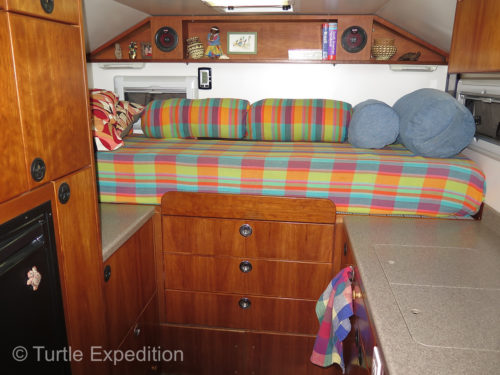
During the day the bed is perfect for a quick nap, even for two.
Below the bed are three full-extension drawers, two for clothing (one drawer each!), one season at a time. The top drawer for general stationary; batteries, chargers, paper, a portable printer and a portable photo printer, etc. The shelf above the bed is a good place for books and a few knickknacks that make the camper feel like home, even for a one night stop. Lightweight items are held in place with Velcro. The collapsible bed with pre-fitted sheets, accomplishes one of our primary goals in the design. We wanted the camper to be as big on the inside but as small as possible on the outside.
The bed is a 5” medium density mattress with a natural wool cover and fitted sheets. During the day it folds in half and the front base slides into the lower base, creating a comfortable day-bed. At night, it takes 30 seconds to make the full bed, leaving one sink open. All pillows, down comforter, light blanket and down jackets store in stuff bags that also serve as pillows as needed.
Refrigerator

Next to the entry door is the refrigerator and cabinets purposely positioned over the wheel well.
Ice chests are a fond memory. When you fill an ice chest with ice at the market, there is little room for food. We installed a Dometic CoolMatic Compressor refrigerator with a freezer. It runs on 110V or 12V and does not need to be level, unlike the more common absorption types. On 12V it draws only 6 Amps with a low voltage cut-out, and it is extremely quiet.
After trying a couple of other brands over the years our Dometic Coolmatic compressor refrigerator has been ideal. It’s extremely quiet and can even make ice cubes, freeze ice cream or week’s worth of chicken or fish.
Above, on the side and below are large storage cabinets used for storage of household items.
Safe Water
Safe water is a must. We installed the Everpure dual-filter Superchlorination/Dechloination system we have used for many years. The Everpure system uses a method suggested by the U.S. Environmental Protection Agency (EPA). Most towns and cities use chlorine to purify their water, which is why it can often taste like a swimming pool. We add 8 drops of chlorine bleach per gallon which is available all over the world. It’s not always an exact measurement because sometimes we have to guess how much water is left in the tank. There is a small test kit if you are worried. A little more doesn’t hurt. The chlorine kills bacteria and most importantly, viruses.

The two easy-to-change Everpure filters can last for months. We can fill our 40-gallon water tank and jerry cans from creeks, lakes, rivers, irrigation ditches or any water faucet in any village or gas station.
The first-stage coarse filter takes out dirt, sand and big stuff. The secondary primary filter, with a pore size of 0.5 micron, removes the chlorine and other foul tastes and odors, asbestos and industrial wastes, amoebas, giardia and their cysts but not salt. (In case you wondered, 0.5 micron is 1/50,000 of an inch. One micron is 0.001 mm or 0.00004 inches.). It feeds the small secondary faucet at the sink used for all cooking and drinking with sparkling clear premium-quality water. The main sink faucet has hot and cold water, which is also purified, (Superchlorination), but may have a slight chlorine taste. It is perfectly fine for washing and bathing, and you could even drink it. The hand-held sprayer head is handy for a quick hair wash.
The two easy-to-change Everpure filters may last for months. We can fill our 40-gallon water tank and jerry cans from creeks, lakes, rivers, irrigation ditches or any water faucet in any village or gas station.
Water Storage
A 40-gal water tank is mounted under the floor of the dinette, keeping the weight low. If we are careful, that’s enough for ten days and we carry two 5-gal. jerry cans for reserve. The jerry cans can also be used to transport water to the truck when there is no hose. A reliable ShurFlo 4008 water pump sends water to the filters, sink and showers at 3 gal. per minute. In case you wondered, a nice long hot shower, (turn the water off while soaping up and shaving), uses 3 gallons of water.
Hot Water, a Luxury
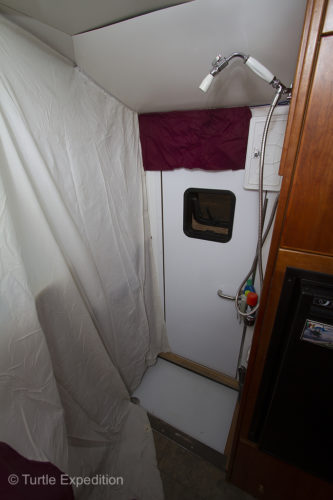
The roomy shower in the doorway is a German idea for a space that’s always there. It’s great when it’s not practical to use our outdoor shower.
Hot water is a luxury and it’s so easy. We installed an Eberspaecher, (Espar), D5 Hydronic Coolant Heater. This small compact unit is plumbed to the cooling system of the engine. It burns a minuscule amount of diesel from the main tank. Its Espar barometric altitude compensator was tested in Tajikistan at over 14,000 ft. It has its own little internal pump and heats the engine coolant to about 160°F. We designed valves and transfer manifolds to direct that 160°F coolant to whatever we need to heat. It can preheat the engine on a cold morning, or heat the camper using a small radiator, or if we send that hot coolant to the Kelvion Plate heat exchanger and pump cold water through it, we have hot water in about 3 minutes after we push the remote start button on the D5 Hydronic., (next to my bed). We use a Watts Series MMV thermostatic mixing valve to keep the water temperature at the kitchen or shower to a safe 120°F. Since the system is directly connected to the engine’s coolant, the small radiator in the camper and hot water will work any time the engine is running.
What? No separate Bath/Shower?
Bathing and going to the bathroom are both very important elements of a practical comfortable camper for long-term travel overland in undeveloped countries, or anywhere else for that matter. Where do you put a 3ft X 3ft X 6.5ft space in a small camper, just for occasional use? The Germans figured this out too. Use the doorway! It is a space that is always there. We designed a sunken entry that drains into a separate 12-gallon holding tank. (Great for washing muddy shoes) A light coated ripstop nylon shower curtain encloses the exposed interior part of the entry and gives us a relatively large shower with plenty of elbow room. It is much bigger than the 19in X 27in entry pad which has plenty of room for our feet and room to move around. Shower head and controls are in an entry wall compartment. The wet ripstop curtain dries in a few minutes.
When you gotta go, you gotta go!

Being able to disconnect the toilet seat from the storage tank makes it easy to dispose of the black water.
Going to the toilet is an interesting subject with options, but for sure, you will need to go. A shovel behind a bush works. A folding toilet seat is nice. A small trash can with a plastic bag under your folding toilet seat is an indoor option. The Thetford Porta Potti 365 with electric flush has a 5.5 gal holding tank, enough for about 56 flushes. On the road, if we don’t fill it up with pee, it can last two weeks. Dumping is not a big problem. In the wild, you can dig a hole and cover it up. Otherwise, any outhouse, squat pit toilet or gas station works. The clear advantage of a Porta Potti is that it is “portable”, unlike the equally popular cassette toilets that need to be bolted to the floor in their own little room. Our Porta Potti slides out on HD tracks into the doorway. There when we need it. Gone when we don’t. If you prefer, it’s portable, so you can pick it up and move it. Privacy?? Really, if you are traveling in a third-world country in a small camper for a year or more and you can’t go to the bathroom in front of the person you are traveling with, what can we tell you? You might be better off with a classic slide-in camper with the standard shit-shower-brush-your-teeth-and-cook-breakfast-all-at-the-same-time-please-and-don’t-get-the-toilet-paper-wet-bathroom. I should mention here that like many overland travelers have discovered, at night we use a “pee jar”. Don’t fill the Porta Potti up with water or pee.
Sink or no sink
We also had to decide if we needed a special little sink in a special little room to brush our teeth and a separate sink to wash dishes when we could touch both sinks without moving our feet. They both drain into the same holding tank! Easy choice huh? We brush our teeth in the kitchen. All grey water goes to a separate 14-gallon holding tank that we drain daily or when it is convenient. It’s big enough for several days if we conserve water.
Electric Power
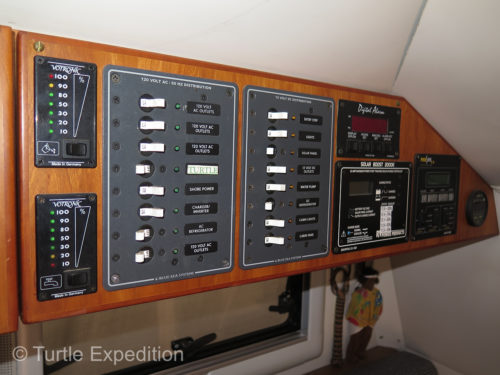
All power, both 12V DC and 110V AC, is controlled by Blue Sea marine circuit breakers. There are almost no fuses in the camper.
Electric power is a necessity today. After testing other brands over the years, when we built The Turtle V we started using Odyssey Extreme AGM batteries. We use 4 34/78-PC1500s in the camper, also installed under the dinette floor, and two of the same size as starting batteries. If one should fail, they are all interchangeable and it is a basic size that can be found anywhere automotive parts are sold. The camper batteries are wired so that we are drawing from all four at the same time, not just battery #1. Odyssey Extreme AGM batteries are deep cycle, marine and starting, all in one.
Electric Power Sources
The house batteries are kept charged on the road by an auxiliary 200-amp alternator that is run though a remote Balmar marine regulator. The main 160-amp alternator charges the two starting batteries. The Turtle V came from the factory with the dual-alternator ambulance package. We also installed two BP85 solar panels on the roof that run through a Blue Sky Energy Solar Boost 3000i controller. A ProSine 2.0 2000-watt inverter supplies 110AC for charging computers, camera batteries and other electrical tools. In addition, the Prosine 2.0 incorporates 100-amp converter/battery charger that we configured down to 25-amps when we are plugged into shore power. It automatically drops to a maintenance level when the truck is stored for a long period of time. A separate 220V to 110V step-down converter is used when we are in countries that use only 220 volts AC.
Circuit Breakers and Wiring

Therm-O-Link wire does not melt or burn in the case of a short.
All power, both 12V DC and 110V AC, to everything that uses power, is controlled by Blue Sea marine circuit breakers. There are almost no fuses in the camper. All wiring was done using Therm-O-Link wire that will not melt in case of a short. All connections were made with Quick Cable lead free solder or heat shrink terminals. All wiring was laid and routed on the inside of the camper walls before Formica siding and cabinets were installed.
Heaters
Our primary heater, a diesel-powered Eberspaecher (Espar) Airtronic, is tucked away behind one of the kick boards under the sink. A second heater, a small Hunter radiator, takes hot coolant from the engine while driving to keep the camper warm if we open the valve for that purpose and turn its fan on.
Lighting
Lighting is very important. Despite the advantages of all the new LED lights, we stayed with the warm Optronics and Hella fluorescents used in previous campers. Seven overhead and two reading lights fill the darkness wherever they might be needed.
Fans
We do not have air conditioning. Since we rarely stay in campgrounds where shore power might be available, two Fan-Tastic Vents and a couple of small portable fans keep air moving when temperatures climb. We didn’t want to deal with carrying a generator and separate fuel.
Music
Music is nice to have at home, so why wouldn’t we want it in our camper? Four speakers give surround sound. The Kenwood AM/FM radio allow us the balance the sound, front to back, depending on where we are. It will play CDs, flash sticks and the collection on our iPod. No, we do not have a TV.
-

-
Our dinette table can sit four in a pinch, but it was sized and designed for two adults and it does not make into a bed.
-
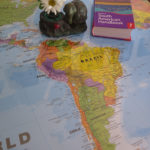
-
A map showing where we are and where we’re going is a great conversational piece during dinner.
-
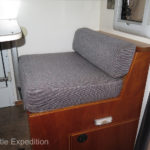
-
Six-inch medium dense foam seats with reclined backs are ideal for working, eating or just relaxing.
-

-
Having a place to throw dirty clothes is a great convenience.
-
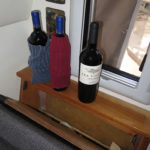
-
Old socks placed around wine bottles makes the compartment behind a seat a wine cellar when it’s not filled with dirty clothes.
-

-
The double-pane pass-through window to the cab is made of Lexan and securely locked from inside.
-

-
When we camp, we unlock the crawl-through window in the cab in case we need to climb through in an emergency.
-
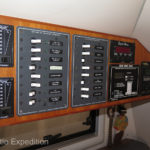
-
All power, both 12V DC and 110V AC, is controlled by Blue Sea marine circuit breakers. There are almost no fuses in the camper.
-
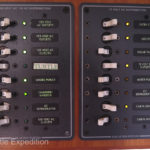
-
At a glance we can tell which systems are being powered and which ones are off.
-

-
The ProSine information panel gives us current battery voltage, rate of charge, battery temperature and enables us to switch from inverter to charger.
-

-
The Xantrax Link 10 gives us the exact level of charge in our Odyssey batteries and how many amp hours we have left.
-

-
The Solar Boost 2008 allows us to take advantage of the maximum capacity of our BP 85 solar panels.
-

-
The Corian we used for countertops has survived extremely well. Small scratches can be polished out.
-

-
Because we do most of our own cooking on the road, a large work area in the kitchen was very important. One sink can be covered for even more working space.
-

-
Overhead shelves in the kitchen were designed to hold what we knew was going to be stored there.
-
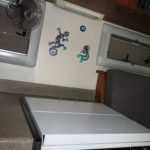
-
When we are not cooking, the enamel cover on the stove adds additional working space.
-

-
Our three burner Amanda propane stove with a front super burner has withstood the test of time and thousands of meals. Whenever practical we usually cook meat on our Weber Go-Anywhere propane grill outside or over a fire.
-

-
The compact folding Coleman oven is amazingly efficient and a bit of a luxury.
-
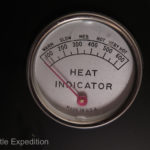
-
The oven’s heat is remarkably accurate.
-
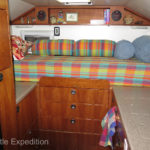
-
During the day the bed is perfect for a quick nap, even for two.
-
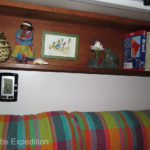
-
The shelf above the bed is a good place for books and a few knickknacks that make the camper feel like home, even for a one night stop.
-

-
The collapsible bed during the day accomplishes one of our primary goals in the design to make the camper as big on the inside as possible and small on the outside.
-

-
Under the lower mattress we added plastic waffle mats to prevent moisture created by body heat on a cold surface.
-

-
Below the bed are three full-extension drawers. two for clothing and one for stationery.
-
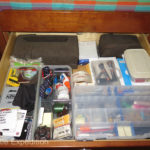
-
The top drawer is used for general stationary; batteries, chargers, paper, a portable printer and a portable photo printer.
-
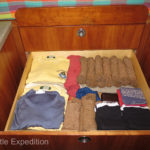
-
Yup, one drawer of clothes each!
-
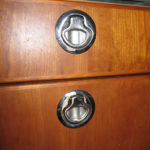
-
Stainless SouthCo marine latches were used to keep drawers and doors closed on rough roads.
-

-
Next to the entry door is the refrigerator and cabinets purposely positioned over the wheel well.
-
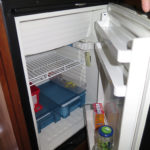
-
The Dometic Coolmatic compressor refrigerator has been ideal. It’s extremely quiet and can even make ice cubes, freeze ice cream or week’s worth of chicken or fish.
-
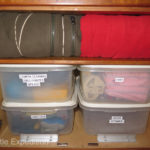
-
Careful planning makes use of every square inch. Labels and organization make things easy to find.
-

-
Cabinets were built exactly to fit what they would be used for, like the Pelican Cases we use for computers and cameras.
-

-
A file drawer holds all our important papers, travel documents and information on where we’ve been and where we’re going.
-
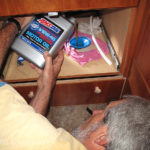
-
A 14-gallon oil reservoir is filled before a major trip from inside the camper. An oil spout/faucet is on the outside.
-
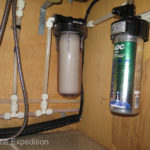
-
The two easy-to-change Everpure filters can last for months. We can fill our 40-gallon water tank and jerry cans from creeks, lakes, rivers, irrigation ditches or any water faucet in any village or gas station.
-
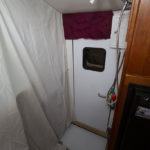
-
The roomy shower in the doorway is a German idea for a space that’s always there. It’s great when it’s not practical to use our outdoor shower.
-

-
A magnetically closing screen curtain keeps bugs out.
-

-
The lower storage tank of the Thetford Porta Potti is easily carried to an appropriate place for dumping.
-

-
All waste is completely sealed inside the lower tank of the Porta Potti.
-

-
The top separates from the base holding tank which can be easily carried to a location where it can be dumped.
-

-
The Thetford Porta Potti seat is big enough for adults.
-

-
The toilet slides out on tracks and can be moved anywhere.
-
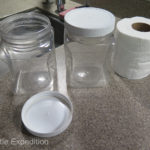
-
As many overland travelers have discovered, at night we use a “pee jar”. Throw it in the bushes in the morning.
-

-
Tucked away on slide-out tracks, our Thetford Porta Potti is out of the way until we need to use it.
-

-
Therm-O-Link wire does not melt or burn in the case of a short.
-
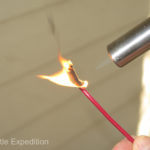
-
This is a normal automotive wire that easily burns when heated with a torch.
-

-
When heated, Quick Cable connectors prevent any possible corrosion or separation.
-

-
All wire connections use Quick Cable lead-free solder or Quick Cable heat-shrink terminals that grip, glue and seal the two wires.
-

-
Our four Odyssey Extreme batteries positioned under the dinette behind the water storage tank to keep the center of gravity as low as possible.
-
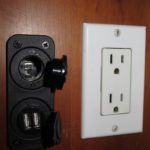
-
Throughout the camper there are 110-V plugs, 12-V plugs and USB plugs.
-
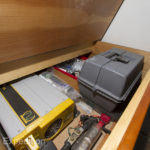
-
A PROsine 2.0 2000-watt inverter supplies 110AC for charging computers, camera batteries and other electrical tools and also incorporates a 100-amp converter/battery charger that we configured down to 25-amps when we are plugged into shore power.
-
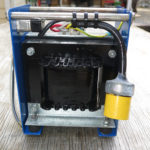
-
A separate 220V to 110V step-down converter is used when we are in countries that use only 220 volts AC.
-

-
No waste of space & no bottomless pits. Tools must be accessible without unpacking gear and digging.
-

-
A horn button inside the camper can often scare away potential intruders, humans and animals alike.
-
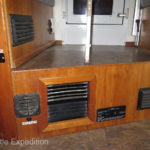
-
From left to right: horn button, Eberspaecher air intake and off-on switch for Hunter heater fan, Hunter radiator output, CO2 LP detector, battery compartment vent, master 12 V breaker switch.
-

-
On the road, a small Hunter radiator takes hot coolant from the engine to keep the camper warm if we open the valve for that purpose and turn its fan on.
-
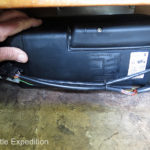
-
Our primary heater is a diesel-powered Eberspaecher (Espar) Airtronic, is tucked away behind one of the kickboards under the sink.
-
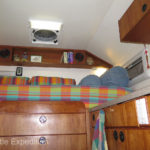
-
We installed plenty of fluorescent lights everywhere they might be needed. We do not like the harsh LED lights for living in such a small space.
-
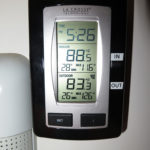
-
An inside/outside thermometer & clock by our bed is a nice convenience.
-
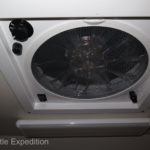
-
Temperature-controlled Dometic Fan-Tastic Vents can move a huge amount of fresh air in or stale hot air and cooking odors out in seconds. Cracking a window by our bed creates a gentle breeze at night.
-
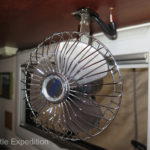
-
A couple of small oscillating fans can be moved around the camper to direct air where we want it.
-

-
The controls for music, the heater, the hot water heater and in the roof mounted remote GoLight are conveniently located right by our bed.
-
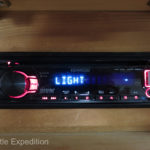
-
A Kenwood AM/FM radio and CD player also accepts flash sticks or the USB plug from our iPod or iPhone.
-
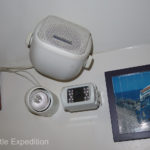
-
A small reading light and one of four speakers for music are mounted next to our Total Vision camera. We can watch for problems from the screen in the cab on rough roads.
-
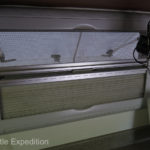
-
Dometic Seitz windows feature privacy screens from the bottom up and mosquito screens from the top down.






